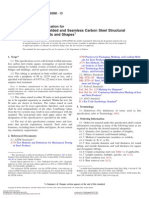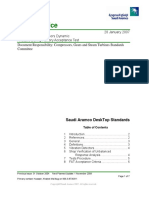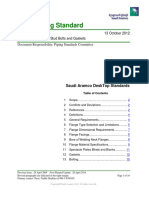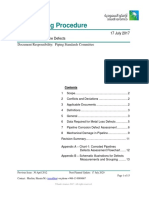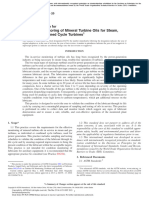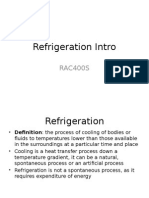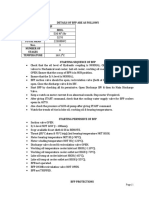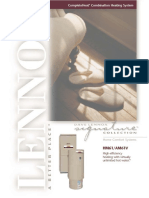Professional Documents
Culture Documents
Saes G 116
Saes G 116
Uploaded by
Yaser AhmadOriginal Description:
Original Title
Copyright
Available Formats
Share this document
Did you find this document useful?
Is this content inappropriate?
Report this DocumentCopyright:
Available Formats
Saes G 116
Saes G 116
Uploaded by
Yaser AhmadCopyright:
Available Formats
Engineering Standard
SAES-G-116 1 July 2019
Cleanliness Standard for Lube/Seal Oil and Fluid Power Systems
Document Responsibility: Vibration and Lubrication Standards Committee
Contents
1 Scope ................................................................ 2
2 Conflicts and Deviations ................................... 2
3 References........................................................ 2
4 General ............................................................. 3
5 Preparatory Inspection ...................................... 3
6 Flushing and Operating Oil ............................... 4
7 Chemical Cleaning and Flushing Procedures ... 4
8 Acceptance after Cleaning and Flushing .......... 4
9 Acceptance for Service ..................................... 5
Revision Summary................................................... 5
Previous Issue: 27 May 2014 Next Planned Update: 1 July 2024
Page 1 of 8
Contact: Aidarous, Mamdouh B. (aidaromb) on phone +966-13-8809718
©Saudi Aramco 2019. All rights reserved.
Saudi Aramco: Company General Use
Document Responsibility: Vibration and Lubrication Standards Committee SAES-G-116
Issue Date: 1 July 2019
Next Planned Update: 1 July 2024 Cleanliness Standard for Lube/Seal Oil and Fluid Power Systems
1 Scope
This standard specifies the minimum cleanliness requirements of shop and field fabricated
and demothballed or existing Lube/Seal Oil and Fluid Power Systems. (Fluid power
systems are defined as motor driven variable speed hydraulic couplings and driven
equipment utilizing a common fluid for lubrication and power transmission).
Use applicable procedures listed in SAEP-1028 to accomplish and maintain the
minimum acceptance standard of cleanliness specified herein for all lube, seal oil, and
fluid power systems.
2 Conflicts and Deviations
2.1 Any conflicts between this document and other applicable Mandatory Saudi
Aramco Engineering Requirements (MSAERs) shall be addressed to the
EK&RD Coordinator.
2.2 Any deviation from the requirements herein shall follow internal company
procedure SAEP-302.
3 References
The selection of material and equipment and the design, construction, maintenance and
repair of equipment and facilities covered by this standard shall comply with the latest
edition of the references listed below, unless otherwise noted.
3.1 Saudi Aramco References
Saudi Aramco Engineering Procedures
SAEP-302 Waiver of a Mandatory Saudi Aramco Engineering
Requirement
SAEP-1028 Chemical Cleaning of Lube/Seal Oil and Fluid
Power Systems
Saudi Aramco Engineering Standard
SAES-A-008 Chemical Cleaning Requirements
3.2 Industry Codes and Standards
International Organization for Standardization
ISO 4406 Hydraulic Fluid Power - Fluids - Method for
Coding Level of Contamination by Solid Particles
Saudi Aramco: Company General Use
©Saudi Aramco 2019. All rights reserved. Page 2 of 8
Saudi Aramco: Company General Use
Document Responsibility: Vibration and Lubrication Standards Committee SAES-G-116
Issue Date: 1 July 2019
Next Planned Update: 1 July 2024 Cleanliness Standard for Lube/Seal Oil and Fluid Power Systems
American Society for Testing and Materials
ASTM D445 Standard Test Method for Kinematic Viscosity of
Transparent and Opaque Liquids (and
Calculation of Dynamic Viscosity)
ASTM D1744 Standard Test Method for Determination of Water in
Liquid Petroleum Products by Karl Fischer
Reagent
ASTM D664 Standard Test Method for Acid Number of
Petroleum Products by Potentiometric Titration
ASTM D5185 Standard Test Method for Multielement
Determination of Used and Unused Lubricating
Oils and Base Oils by Inductively Coupled Plasma
Atomic Emission Spectrometry (ICP-AES)
ASTM D2272 Standard Test Method for Oxidation Stability of
Steam Turbine Oils by Rotating Pressure Vessel
4 General
Shop fabricated lube, seal oil, and fluid power systems' components may have been
cleaned, inspected and tested prior to shipment to the field. However, shipping, storage,
field inspection, and installation usually result in contamination of the previously
cleaned system. Therefore, it is necessary to carefully inspect these systems and clean
to remove any contaminants.
5 Preparatory Inspection
5.1 Prior to commencing erection of field fabricated piping and components of lube,
seal oil and fluid power systems, foreign objects such as weld slag, metal
shavings, spatter, insoluble preservatives/compounds, icicles, and burnt residue
shall be removed by mechanical and chemical cleaning at grade level.
5.2 All systems piping, manways, removable headers, filters, coolers, temporary
bypass piping, etc., shall be inspected for cleanliness prior to installation and
bolting.
5.3 All accessible welds on pipes and fittings shall be inspected for the presence of
weld slag. If slag is found, it shall be removed.
5.4 All surfaces in contact with oil shall have a uniform clean metallic color.
The surfaces, when viewed without magnification, shall be free of visible rust,
mill scale, welding slag, corrosion, oxides, paint or other foreign material.
Saudi Aramco: Company General Use
©Saudi Aramco 2019. All rights reserved. Page 3 of 8
Saudi Aramco: Company General Use
Document Responsibility: Vibration and Lubrication Standards Committee SAES-G-116
Issue Date: 1 July 2019
Next Planned Update: 1 July 2024 Cleanliness Standard for Lube/Seal Oil and Fluid Power Systems
5.5 All internal surfaces of component parts of field fabricated lube, seal oil and
fluid power systems, shall be cleaned as described in SAEP-1028, prior to
flushing with oil.
5.6 If the internal surfaces of any component parts of a shop fabricated lube, seal oil
and fluid power systems do not meet the requirements of paragraph 5.4, the
affected system shall be cleaned in accordance with SAEP-1028 before flushing
with oil.
5.7 Field fabricated tie-in piping shall be isolated and cleaned independently of shop
fabricated lube, seal oil and fluid power systems which comply with paragraph 5.4.
6 Flushing and Operating Oil
6.1 To avoid compatibility problems, the system shall be flushed with the same
operating oil. The operating oil shall be approved by the Chairman, Vibration
and Lubrication Standards Committee, Consulting Services Department.
6.2 A reference fresh oil sample of the operating oil shall be analyzed before
starting the flushing process. The following physical and chemical analyses
shall be carried out: Color, Appearance, Viscosity at 40 ̊C (ASTM D445),
Moisture content (ASTM D1744), Acid Number (ASTM D664), Spectrometric
Analyses (ASTM D5185), RPVOT (ASTM D2272) where applicable, and
Particle Count (ISO 4406).
7 Chemical Cleaning and Flushing Procedures
7.1 Chemical cleaning procedure shall be per applicable procedures of SAEP-1028.
7.2 Flushing procedure shall be as per Appendix I.
8 Acceptance after Cleaning and Flushing
After a minimum of 24 hours continuous flushing, a final cleanliness check shall be
made. The inspection screens shall be cleaned and reinstalled and the flushing oil shall
be circulated for an additional period of 12 hours. The system is clean if:
8.1 No visible accumulation of dirt/foreign material is found on the screens after
12 hours of circulation.
8.2 Moisture cannot be detected using the Lube Oil Condition Monitoring Program
Laboratories' hot plate crackle test method.
8.3 All surfaces in contact with oil shall have a uniform clean metallic color.
Accessible surfaces, when viewed without magnification, shall be free of visible
Saudi Aramco: Company General Use
©Saudi Aramco 2019. All rights reserved. Page 4 of 8
Saudi Aramco: Company General Use
Document Responsibility: Vibration and Lubrication Standards Committee SAES-G-116
Issue Date: 1 July 2019
Next Planned Update: 1 July 2024 Cleanliness Standard for Lube/Seal Oil and Fluid Power Systems
metal deposit, preservatives, welding slag, rust, corrosion, oxides, paint or other
foreign material.
8.4 The cleanliness of the system is acceptable to the Saudi Aramco proponent
organization's Operations personnel.
9 Acceptance for Service
9.1 After flushing is completed per Appendix I, fill the system with clean unused
service oil.
The same oil used for flushing can also be used for in-service if the reviewed oil
sample condition is acceptable by the Chairman, Vibration and Lubrication
Standards Committee, Consulting Services Department.
9.2 Establish normal lube, seal oil and fluid power system flows in preparation for
equipment start-up.
9.3 Circulate for two hours and collect a composite two liter sample from different
drains. Send the sample to Southern Area Laboratories Division at Abqaiq for
the chemical and physical analyses listed in paragraph 6.2. The system oil will
be considered acceptable for service, by CSD Lubrication Engineer, when:
The particle count, in accordance with ISO 4406, is 17/15/12 or less.
If two-range ISO codes are used, the particle count shall be 15/12 or less.
The moisture content, in accordance with ASTM D1744, is 200 PPM or less.
The rest of physical and chemical analyses are within the acceptable levels
for new oil.
The sample bottle must be clearly labeled “Final Fill Sample for the attention of
the CSD Lubrication Engineers”.
Revision Summary
27 May 2014 Revised the Next Planned Update, reaffirmed the content of the document, and reissued as
major revision.
1 July 2019 Major revision included the following modifications:
- Added Oil Flushing Procedure in Appendix since it was removed from SAEP-1028
- Modified ISO cleanliness level to 17/15/12
- Updated reference list
Saudi Aramco: Company General Use
©Saudi Aramco 2019. All rights reserved. Page 5 of 8
Saudi Aramco: Company General Use
Document Responsibility: Vibration and Lubrication Standards Committee SAES-G-116
Issue Date: 1 July 2019
Next Planned Update: 1 July 2024 Cleanliness Standard for Lube/Seal Oil and Fluid Power Systems
Summary of Change (1 July 2019)
Paragraph Change Type
No. Technical Change
No. (New, Modification)
Allowing the use of cleaned and filtered used
1 9.1 Modification flushing oil as in service oil when meeting the
specification of new oil
2 9.3 Modification Modified ISO cleanliness level to 17/15/12
3 Addition Oil flushing procedure is added in Appendix I
Saudi Aramco: Company General Use
©Saudi Aramco 2019. All rights reserved. Page 6 of 8
Saudi Aramco: Company General Use
Document Responsibility: Vibration and Lubrication Standards Committee SAES-G-116
Issue Date: 1 July 2019
Next Planned Update: 1 July 2024 Cleanliness Standard for Lube/Seal Oil and Fluid Power Systems
Appendix I - Oil Flushing
1. After cleaning and drying the system, remove any temporary bypass connections other than
those bypassing bearings, seals and gearboxes, and leave them in place until flushing is
completed. Hand clean the areas that remain bypassed with lint-free cloths prior to system
start-up.
2. Place 100 x 100 wire mesh stainless steel (9CAT 1000284291) screens between a pair of
rubber gaskets (not asbestos), and installed flanges. Use 4 x 4 wire mesh backup screens
(9CAT 1000284291) to prevent collapse at high flow rates. Remove and install new
inspection screens in the lube and seal oil return piping at the reservoir flanges every 8 hours.
Monitor flushing of solids by inspecting these screens. Keep the old screens tagged
sequentially and with their location and removal time. If absolute filters are installed, instead
of screens examine oil samples on a glass plate every 8 hours under microscope.
3. After drying, within 2 hours start flushing the lube/seal oil and fluid power systems with oil
specified for the operating system for a period of approximately 48 hours to remove loose
material in system. Flush the system at a velocity of at least 3 m/s, or at the maximum velocity
limited by the MAOP in the larger lines. If the existing oil pumps cannot provide adequate
circulation either in series, parallel, or high-speed operation, temporary circulation pumps
shall be installed for the flushing operation. Monitor oil flushing velocity by (1) flow meters,
(2) comparing the differential pressure to the pump's head capacity curve, or (3) ammeters
on the motors.
4. When many parallel flow paths are present in the flushing circuit, selectively close off paths
to force enough flow in each path to achieve 3 m/s minimum velocity.
5. If the presence of water is detected due to incomplete drying of the system, add 5% solution
of Diethylene Glycol to scavenge the water. After circulating for 2 hours, drain the system at
the reservoir flanges.
6. When system flush is near completion, stop flushing, drain the system at the reservoir flanges
remove all valves, including block, CVs, self-actuated CVs, etc., clean manually with lint-
free cloths and replace.
7. Inspect and verify cleanliness of all temporary flushing equipment such as pumps, heat
exchangers, piping, hoses and filters, in order not to add dirt to the system. Install at the outlet
additional screens of each item of temporary flushing equipment.
8. If the system is segmented conducted the flush in a systematic manner to clean it sequentially
from inlet to outlet, preventing re-contamination a section of the system that has already been
flushed.
9. Periodically blow down drains, instrument connections and vents to remove accumulated
water in low points in each shift during the flushing.
Saudi Aramco: Company General Use
©Saudi Aramco 2019. All rights reserved. Page 7 of 8
Saudi Aramco: Company General Use
Document Responsibility: Vibration and Lubrication Standards Committee SAES-G-116
Issue Date: 1 July 2019
Next Planned Update: 1 July 2024 Cleanliness Standard for Lube/Seal Oil and Fluid Power Systems
10. Slowly and repeatedly stroke valves between the nearly closed and fully open positions to
create turbulence in the valve bonnet cavities, to flush them.
11. During flushing apply thermal, mechanical and hydraulic shock to dislodge foreign material.
12. Thermal Shock
During flushing vary the oil temperature from 38°C to about 80°C, alternately using the lube
oil cooler and the heating coil.
13. Mechanical Shock
Use a small plastic or copper hammer at weld joints, fittings and other areas that trap material
frequently during flushing cycles.
14. Hydraulic Shock
Shock the system occasionally by interrupting the flow. Shut down the pump completely and
wait for five minutes to allow for complete draining of lines. Restart the pump and restore
full flushing velocity.
15. After 24 hours of flushing, install the equipment manufacturer's specified filter or 10 micron
filter cartridges, whichever has the lower pore rating. Change filter cartridges if the
differential pressure approaches by-pass pressure. Where heavy fouling of particular
components is observed, install temporary 50 microns filters on the outlet piping of such
components before installing the 10-micron equipment filters. Flush the system for 24 hours.
Inspect the 50-micron filters and continue flushing with clean filters if necessary, until the
heavily fouled components are considered sufficiently clean to allow installation of the 10-
micron equipment system filters.
Saudi Aramco: Company General Use
©Saudi Aramco 2019. All rights reserved. Page 8 of 8
Saudi Aramco: Company General Use
You might also like
- 26 Samss 088Document8 pages26 Samss 088Fayez Al-ahmadiNo ratings yet
- 09 Samss 070Document11 pages09 Samss 070NASIR SYEDNo ratings yet
- 20 Samss 001Document9 pages20 Samss 001asimazami690% (1)
- Materials System SpecificationDocument17 pagesMaterials System Specificationnadeem shaikhNo ratings yet
- D6224-09 Standard Practice For In-Service Monitoring of Lubricating Oil For Auxiliary Power Plant EquipmentDocument15 pagesD6224-09 Standard Practice For In-Service Monitoring of Lubricating Oil For Auxiliary Power Plant EquipmentAlabbas FadhelNo ratings yet
- Astm A500Document6 pagesAstm A500notsofar100% (4)
- Container Handbook PDFDocument975 pagesContainer Handbook PDFBaher Saleh0% (1)
- SABP G 002 AramcoDocument7 pagesSABP G 002 Aramcom4metz100% (1)
- Sabp G 024Document15 pagesSabp G 024Krishnamoorthy100% (1)
- Sabp G 022Document8 pagesSabp G 022Hassan MokhtarNo ratings yet
- Sabp G 006Document8 pagesSabp G 006Li PengNo ratings yet
- Sabp G 023Document13 pagesSabp G 023Krishnamoorthy100% (1)
- Engineering Standard: SAES-H-200 30 March 2020 Storage, Handling, and Installation of Coated PipesDocument10 pagesEngineering Standard: SAES-H-200 30 March 2020 Storage, Handling, and Installation of Coated PipesMuhammad AsifNo ratings yet
- Sabp G 001Document12 pagesSabp G 001m4metz100% (1)
- 175-022501 Flanges (WN, BL, Forged Steel & As)Document2 pages175-022501 Flanges (WN, BL, Forged Steel & As)ALINo ratings yet
- Saep 201 PDFDocument5 pagesSaep 201 PDFRami ElloumiNo ratings yet
- Mex 21305Document39 pagesMex 21305Yousef Adel Hassanen100% (1)
- Sabp G 001 PDFDocument12 pagesSabp G 001 PDFKemoH100% (1)
- Saep 1144Document23 pagesSaep 1144Amit shahNo ratings yet
- Saudi Aramco Inspection Checklist: Receiving Inspection of Positive Displacement Pumps SAIC-G-2009 30-Apr-17 MechDocument18 pagesSaudi Aramco Inspection Checklist: Receiving Inspection of Positive Displacement Pumps SAIC-G-2009 30-Apr-17 Mechkarthi51289No ratings yet
- Materials System SpecificationDocument8 pagesMaterials System Specificationnadeem shaikhNo ratings yet
- Saep 1638Document10 pagesSaep 1638Branko_62No ratings yet
- Materials System SpecificationDocument22 pagesMaterials System SpecificationAwais CheemaNo ratings yet
- 34 Samss 711 PDFDocument26 pages34 Samss 711 PDFFlorin Daniel AnghelNo ratings yet
- SAES-M-005 PDF Download - Design and Construction of Fixed Offshore Platforms - PDFYARDocument8 pagesSAES-M-005 PDF Download - Design and Construction of Fixed Offshore Platforms - PDFYARZahidRafiqueNo ratings yet
- Sabp G 013Document15 pagesSabp G 013Eagle Spirit100% (1)
- 34 Samss 112Document14 pages34 Samss 112naruto256No ratings yet
- Inspection & Testing Requirements Scope:: Test and Inspection PerDocument2 pagesInspection & Testing Requirements Scope:: Test and Inspection PerSelvakpm06No ratings yet
- Saep 324Document13 pagesSaep 324Up WeldNo ratings yet
- Saudi Aramco Typical Inspection Plan Cross Country Above Ground PipeliDocument5 pagesSaudi Aramco Typical Inspection Plan Cross Country Above Ground PipeliShahbaz AhmadNo ratings yet
- Inspection & Testing Requirements Scope:: Test and Inspection PerDocument2 pagesInspection & Testing Requirements Scope:: Test and Inspection PerAbu Anas M.SalaheldinNo ratings yet
- 175 011100Document2 pages175 011100Abu Anas M.SalaheldinNo ratings yet
- 01 Samss 010Document11 pages01 Samss 010biplabpal2009No ratings yet
- Saes L 132Document38 pagesSaes L 132BM TECH100% (1)
- SAIC-L-2042 Rev 6 Field Hydrostatic Testing of Isolation ValvesDocument6 pagesSAIC-L-2042 Rev 6 Field Hydrostatic Testing of Isolation ValvesAhdal NoushadNo ratings yet
- Saic L 2008 PDFDocument4 pagesSaic L 2008 PDFHesham HelalNo ratings yet
- 13 Samss 003 PDFDocument7 pages13 Samss 003 PDFMohamed SolimanNo ratings yet
- Saes L 136Document8 pagesSaes L 136kartik_harwani4387No ratings yet
- 18-SAMSS-493 - Two Part Polyurethane Duct SealantDocument5 pages18-SAMSS-493 - Two Part Polyurethane Duct Sealantmedication abbasNo ratings yet
- SAEP-379 Quality Issues NotificationDocument4 pagesSAEP-379 Quality Issues NotificationMusic And FunNo ratings yet
- Sabp G 004Document7 pagesSabp G 004shyam100% (1)
- 23 Samss 020Document44 pages23 Samss 020nadeem shaikhNo ratings yet
- Materials System SpecificationDocument12 pagesMaterials System SpecificationGOSP3 QC Mechanical100% (1)
- Saic G 2023Document2 pagesSaic G 2023Noor Mohamed AzeezNo ratings yet
- 01-SAMMS-046 Stainless PipeDocument11 pages01-SAMMS-046 Stainless PipesureshNo ratings yet
- Saes L 109Document16 pagesSaes L 109Abdullah RiazNo ratings yet
- Satr S 4002Document1 pageSatr S 4002Noor Mohamed AzeezNo ratings yet
- Saep 306Document15 pagesSaep 306nadeem shaikh100% (1)
- 04-SAMSS-053 - Nov. 28, 2013Document8 pages04-SAMSS-053 - Nov. 28, 2013LainhatanhNo ratings yet
- Ir 175-010000Document2 pagesIr 175-010000Abu Anas M.SalaheldinNo ratings yet
- Schedule B - Attachment IVDocument29 pagesSchedule B - Attachment IVAbdul Ahad LoneNo ratings yet
- Saes A 102Document23 pagesSaes A 102kartik_harwani4387No ratings yet
- Saic A 2011Document8 pagesSaic A 2011jerinNo ratings yet
- SAER1972Document9 pagesSAER1972zamil2008No ratings yet
- Saep 380 PDFDocument10 pagesSaep 380 PDFbassamNo ratings yet
- Satr W 2013Document8 pagesSatr W 2013Rijwan MohammadNo ratings yet
- Saes G 115Document9 pagesSaes G 115junaidNo ratings yet
- Sabp A 082Document27 pagesSabp A 082Ahmed Boraey100% (1)
- D4378 sttb4153Document19 pagesD4378 sttb4153fwinastyNo ratings yet
- In-Service Monitoring of Mineral Turbine Oils For Steam, Gas, and Combined Cycle TurbinesDocument19 pagesIn-Service Monitoring of Mineral Turbine Oils For Steam, Gas, and Combined Cycle TurbinesEhsan ZiaeiNo ratings yet
- Astm D4378-22Document19 pagesAstm D4378-22Hani YilmazNo ratings yet
- SAES-A-205 Change Contact NameDocument27 pagesSAES-A-205 Change Contact Namesaleem naheed100% (1)
- As 4156.3-2008 Coal Preparation Magnetite For Coal Preparation Plant Use - Test MethodsDocument8 pagesAs 4156.3-2008 Coal Preparation Magnetite For Coal Preparation Plant Use - Test MethodsSAI Global - APACNo ratings yet
- Hima Bindhu 3yrs GenpactDocument4 pagesHima Bindhu 3yrs GenpactSudheer Kumar ChunduruNo ratings yet
- It Java PDFDocument266 pagesIt Java PDFvj singhNo ratings yet
- Instruction Manual For Model TC 48 20 and Model TC 48 20 OEM Thermoelectric Cooler Temperature ControllerDocument58 pagesInstruction Manual For Model TC 48 20 and Model TC 48 20 OEM Thermoelectric Cooler Temperature ControllerSamir MadanNo ratings yet
- Rev3rd - Catalogue 2022Document12 pagesRev3rd - Catalogue 2022panchucrutNo ratings yet
- Applications Cloud Using Common FeaturesDocument86 pagesApplications Cloud Using Common FeaturesNguyen Van TraNo ratings yet
- ch18 MSW15 Corrosion PDFDocument41 pagesch18 MSW15 Corrosion PDFMiralda SyakirahNo ratings yet
- Six - Sigama - A Story of XXXDocument2 pagesSix - Sigama - A Story of XXXssiddharthaNo ratings yet
- GSWC STANDARD DRAWINGS 2016 (Final Version) - Part 2Document104 pagesGSWC STANDARD DRAWINGS 2016 (Final Version) - Part 2Hussein MohamedNo ratings yet
- Indoor Location Tracking Using Received Signal Strength Indicator - C-C Pu (2009 LBS Diagram)Document29 pagesIndoor Location Tracking Using Received Signal Strength Indicator - C-C Pu (2009 LBS Diagram)slysoft.20009951No ratings yet
- Flight Unit PlanDocument10 pagesFlight Unit Planapi-308418238No ratings yet
- SFD and BMD in FramesDocument98 pagesSFD and BMD in FramesSYifa ShuhaIliNo ratings yet
- TFP151 07 2018Document8 pagesTFP151 07 2018Mónica BaqueNo ratings yet
- Skid Pack: Monoblock-FilterDocument55 pagesSkid Pack: Monoblock-FilterAsuncion Gomez-Cambronero LoroNo ratings yet
- 13.6 Summary: Trans. AIME 259Document10 pages13.6 Summary: Trans. AIME 259سحر سلامتیانNo ratings yet
- OGP 494 Integrating Safety in Major ProjectsDocument16 pagesOGP 494 Integrating Safety in Major ProjectsLyle KorytarNo ratings yet
- DG201B, DG202B: Vishay SiliconixDocument16 pagesDG201B, DG202B: Vishay SiliconixPhong DoNo ratings yet
- 00000177-03 Oil Tanks HyvaDocument24 pages00000177-03 Oil Tanks HyvaLuffy Albi FradanaNo ratings yet
- Mohammed Abdullah: C#, Tekla ApiDocument1 pageMohammed Abdullah: C#, Tekla ApiMido RmfNo ratings yet
- Noctua NH d15 Manual en Web v2Document6 pagesNoctua NH d15 Manual en Web v2Chetan BhasinNo ratings yet
- Chemistry Form 4 Chapter 9 AlloyDocument12 pagesChemistry Form 4 Chapter 9 AlloyAmir Fikri100% (1)
- HTTP WWW - Ginkosynthese.com Uploads Building Manual v2 5Document1 pageHTTP WWW - Ginkosynthese.com Uploads Building Manual v2 5Andrei Liviu GheorgheNo ratings yet
- Auto Cluster Exhibition Center, Chinchwad, Pune. Auto Cluster Exhibition Center, Chinchwad, PuneDocument4 pagesAuto Cluster Exhibition Center, Chinchwad, Pune. Auto Cluster Exhibition Center, Chinchwad, Punemahwish khanNo ratings yet
- Refrigeration IntroDocument37 pagesRefrigeration Introtixy2013No ratings yet
- BFP SopDocument2 pagesBFP SopRahul KurmiNo ratings yet
- HM61/AM61V: Home Comfort SystemsDocument4 pagesHM61/AM61V: Home Comfort SystemsJames LoewenNo ratings yet
- Complete Solution of Transient Response of Series RLC Circuit For Step ExcitationDocument5 pagesComplete Solution of Transient Response of Series RLC Circuit For Step ExcitationPartha SenguptaNo ratings yet
- Exp 10 Relative Density ApplicationDocument2 pagesExp 10 Relative Density ApplicationLaarni Villalon Ventigan0% (1)





